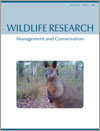Context . When environmental, economic and/or social effects of wildlife are considered undesirable and need to be reduced, managers require knowledge of the effectiveness of candidate control techniques, particularly the relationship between control effort and change in abundance.
Aims . We evaluated the effects of control on the abundances of introduced red deer (Cervus elaphus scoticus) and sika deer (Cervus nippon) at three New Zealand forest sites (two North Island, one South Island) in an 8-year adaptive-management experiment.
Methods . We identified paired areas of 3600 ha at each site that were as similar as possible in geology, physical environments and forest composition and applied deer control (helicopter- and/or ground-based hunting) to a randomly selected member of each pair. The abundances of deer were monitored in each treatment and non-treatment area for up to 7 years by using faecal pellet counts on 50 randomly located transects.
Key results . The difference between deer abundances in the treatment and non-treatment areas was significantly negative at one site, significantly positive at one site and indistinguishable at the other site. Faecal pellet abundances declined with increasing helicopter-based hunting effort but did not change with increasing ground-based hunting effort. There was evidence that aerially sown 1080 baits used for possum control in two treatment areas reduced deer abundances.
Conclusions . The substantial uncertainty surrounding the relationships between deer control effort and changes in deer abundance means that managers cannot assume that the environmental, economic and/or social problems caused by deer will be alleviated with the quantum of control effort applied in the present study.
Implications . Reducing the abundances of deer in forests may require substantially more control effort than is currently believed.





